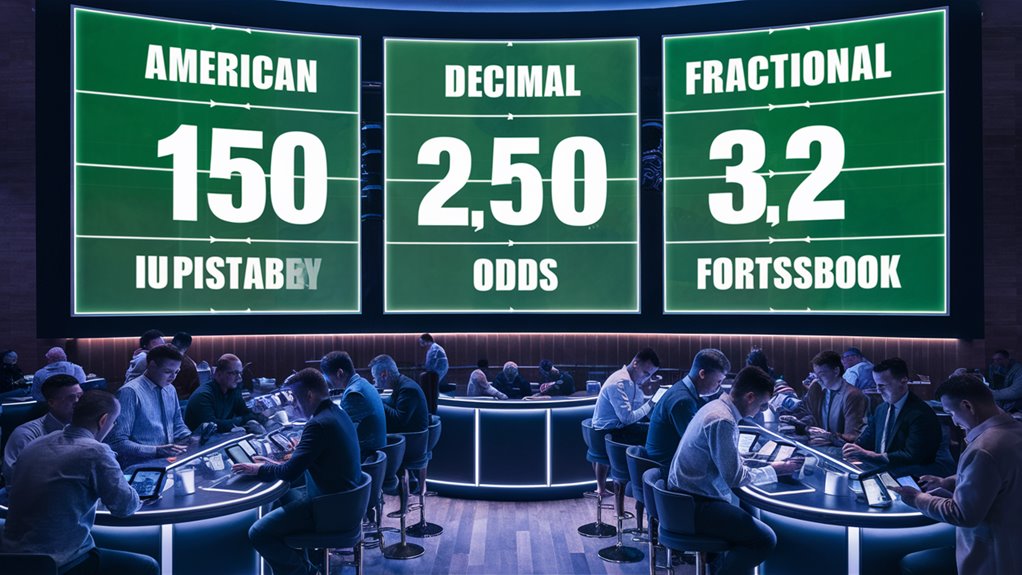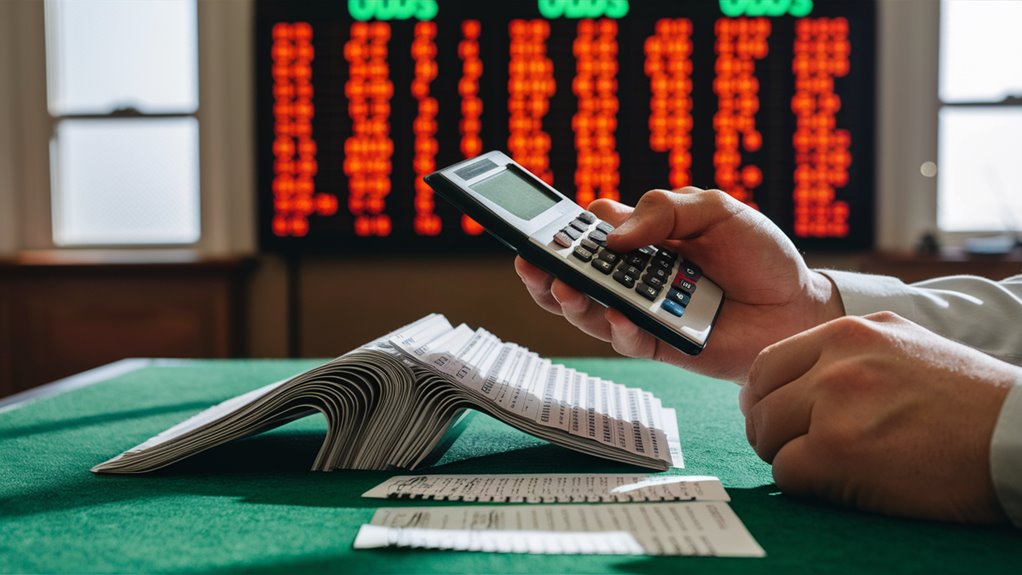How Do You Read Sports Betting Odds Like a Professional?
Key Takeaways
- Sports betting odds represent probability and potential payouts
- Understanding moneyline, decimal, and fractional odds formats
- Converting odds to implied probability reveals betting value
- Professional bettors compare odds across multiple sportsbooks
Sports betting odds decode into a mathematical language that reveals both probability and profit potential in betting markets. Whether examining moneyline (+250), decimal (3.50), or fractional odds (5/2), each format communicates the same essential information through different numerical expressions.
Understanding Different Odds Formats
- Moneyline: Shows how much you win on a $100 bet (positive) or need to bet to win $100 (negative)
- Decimal: Multiply your stake by this number to calculate total return
- Fractional: Displays potential profit relative to stake (5/2 means win $5 for every $2 bet)
#
Converting Odds to Probability
Professional bettors convert odds into implied probability percentages:
- Positive moneyline: 100/(odds + 100) x 100
- Negative moneyline: |odds|/(|odds| + 100) x 100
- Decimal odds: (1/decimal odds) x 100
Finding Betting Value
Compare calculated probabilities against your own assessment of likely outcomes. Real value exists when your probability estimate exceeds the implied odds probability. Think of it like comparison shopping ??finding the best price for your prediction.
Professional Betting Strategies
- Compare odds across multiple sportsbooks
- Track line movements over time
- Calculate exact return on investment for each bet
- Maintain detailed records of all wagers and outcomes
Remember, professional betting requires understanding both the math behind the odds and the factors affecting the underlying events. Start with small stakes while practicing these concepts.
Types of Sports Betting Odds

How Do Sports Betting Odds Work?
Key Takeaways
- Three main types of odds: American (moneyline), decimal (European), and fractional (British)
- American odds use +/- format to show potential winnings or required stakes
- Decimal odds display total returns including initial stake
- Fractional odds indicate profit relative to stake amount
Understanding American (Moneyline) Odds
American odds, displayed as positive or negative numbers, show potential payouts based on $100 stakes.
A +150 means you’ll win $150 on a $100 bet, while -150 requires betting $150 to win $100.
This format dominates North American sportsbooks and online betting platforms.
Calculating Decimal (European) Odds
Decimal odds simplify payout calculations by showing total returns per unit wagered.
With odds of 2.50, a $100 bet returns $250 total, including your original stake.
Popular throughout Europe and Australia, decimal odds offer straightforward multiplication for determining potential winnings.
Working with Fractional (British) Odds
Fractional odds, written as 5/1 or 1/5, demonstrate profit relative to stake.
At 5/1 odds, a $100 bet yields $500 in profit.
These traditional odds remain prevalent in UK horse racing and heritage sportsbooks.
Converting Between Odds Formats
Understanding all three formats becomes essential when:
- Betting on international sports
- Using multiple sportsbooks
- Comparing odds across different platforms
- Seeking the best possible value for your wagers
Each format communicates the same information about potential payouts and implied probabilities, just presented differently for various market preferences and traditions.
Understanding American Odds

How Do American Odds Work in Sports Betting?
Key Takeaways
- American odds use plus (+) and minus (-) symbols to show potential payouts
- Minus (-) odds show how much to bet to win $100
- Plus (+) odds show potential profit on a $100 bet
- All odds work proportionally for any bet amount
Understanding Plus and Minus Symbols
American odds represent the standard betting format across North American sportsbooks, utilizing plus (+) and minus (-) symbols to indicate potential payouts.
A minus sign shows the amount needed to bet to win $100, while a plus sign indicates the profit amount on a $100 bet.
Calculating Negative Odds
When odds show -150, a bettor must risk $150 to win $100. The calculation formula for negative odds is:
- Potential Win = (100 / odds number) × bet amount
- Example: $15 bet at -150 odds = (100/150) × $15 = $10 profit
Calculating Positive Odds
For +150 odds, a $100 bet yields $150 in profit. The calculation formula for positive odds is:
- Potential Win = (odds number/100) × bet amount
- Example: $50 bet at +200 odds = (200/100) × $50 = $100 profit
Proportional Betting
American odds work proportionally for any bet amount.
Bettors aren’t required to wager exactly $100. The same ratio applies whether betting $10 or $1,000, making calculations straightforward once you understand the basic principle.
## Converting Odds to Probability

How Do You Convert Betting Odds to Probability?
Key Takeaways
- American odds use different formulas for positive (+) and negative (-) numbers
- Decimal odds conversion uses a simple 1/decimal formula
- Fractional odds require dividing by the sum of both numbers
- Understanding probability helps identify valuable betting opportunities
Converting American Odds
American odds require two different formulas based on whether the number is positive or negative:
For positive odds (+150):
- Formula: 100/(odds + 100) × 100
- Example: 100/(150 + 100) × 100 = 40% probability
For negative odds (-150):
- Formula: |odds|/(|odds| + 100) × 100
- Example: 150/(150 + 100) × 100 = 60% probability
Converting Decimal Odds
Decimal odds use a straightforward calculation:
- Formula: 1/decimal odds × 100
- Example: For odds of 2.50, calculate 1/2.50 × 100 = 40% probability
Converting Fractional Odds
For fractional odds like 3/1:
- Formula: Second number/(First number + Second number) × 100
- Example: 1/(3+1) × 100 = 25% probability
Practical Application
Regular practice with these conversions develops quick probability calculation skills 먹튀검증 보증업체 This ability allows you to compare your estimated probabilities against bookmaker odds and identify valuable betting opportunities more effectively.
Calculating Potential Payouts

How Do You Calculate Sports Betting Payouts?
Key Takeaways
- Decimal odds: Multiply stake by decimal number for total return
- American odds: Use +/- to determine profit on $100 or stake needed
- Fractional odds: Multiply stake by fraction for potential winnings
- Always add original stake to calculated profit for total return
Understanding Decimal Odds
Decimal odds calculations offer the most 통찰력 있는 스포츠도박 straightforward approach to determining potential payouts.
Simply multiply your stake by the decimal number. For example, a $100 bet at 2.50 odds yields $250 ($100 x 2.50).
Calculating American Odds
American odds use positive and negative numbers to indicate potential profits:
- Positive odds (+150): Shows profit on a $100 stake ($150 win)
- Negative odds (-150): Indicates stake needed to win $100 ($150 stake)
Working with Fractional Odds
To calculate fractional odds payouts:
- Convert fraction to decimal (3/1 = 3.0)
- Multiply stake by this number
- Example: $100 bet at 3/1 = $300 profit
- For 1/2 odds: $100 x 0.5 = $50 profit
Total Return Calculation
To determine your complete payout:
- Calculate the profit using appropriate odds format
- Add your original stake
- This sum represents your total potential return
Remember to verify all calculations before placing bets to ensure accurate expectations of potential returns.
Line Movement Analysis

How Do Sports Betting Lines Move and Why Does It Matter?
Key Takeaways:
- Line movements indicate changing odds from opening to game time
- Sharp money and public betting primarily influence line shifts
- Timing and understanding movement causes are crucial for value betting
Understanding Line Movement Basics
Line movement in sports betting occurs when odds shift between their initial release and game time.
These changes reflect both market activity and new information, making them valuable indicators for bettors seeking optimal positions.
Key Factors Affecting Line Movement
Sharp Money Impact
Professional bettors influence lines through large, analytical-based wagers.
When lines move against public consensus, it often signals sharp money identifying value opportunities in the market.
Public Betting Patterns
Casual bettors typically place wagers based on:
- Popular teams
- Gut feelings
- Recent team performance
- Media influence
How to Track and Analyze Line Movement
- Use odds comparison tools
- Monitor multiple betting websites
- Investigate sudden shifts for:
- Injury reports
- Weather changes
- Team news
- Inside information
Maximizing Value Through Line Movement
Successful line movement analysis requires:
- Quick response to significant shifts
- Understanding underlying movement causes
- Securing the best available numbers
- Tracking historical movement patterns
This systematic approach to line movement analysis helps identify valuable betting opportunities while avoiding common pitfalls in sports wagering.
Finding Value in Odds

How Can You Find Real Value in Sports Betting Odds?
Key Takeaways
- Understanding true probability vs. implied odds reveals valuable betting opportunities
- Expected Value calculations help determine profitable betting scenarios
- Accounting for bookmaker margins ensures accurate value assessment
Understanding Value in Betting Markets
Value betting combines probability analysis with odds comparison to identify profitable opportunities in sports betting markets.
When your calculated probability exceeds the bookmaker’s implied odds, you’ve found potential betting value.
Calculating True Value
Let’s break this down with a practical example:
- Your calculated win probability: 60%
- Bookmaker odds: +150 (implied probability 40%)
- Value gap: 20% (your probability minus implied odds)
This scenario presents clear value because your estimated probability significantly exceeds the market’s assessment.
Using Expected Value Formula
To quantify potential value:
- Expected Value = (Probability × Potential Win) – (1 – Probability × Potential Loss)
- Calculate potential returns based on stake size
- Consider positive Expected Value as potential betting opportunities
Accounting for Bookmaker Margins
Adjust for the bookmaker’s profit margin:
- Convert odds to real probabilities
- Subtract the built-in margin (vig)
- Compare adjusted probabilities with your calculations
- Look for opportunities where value persists after margin adjustment
This systematic approach helps identify genuinely valuable betting opportunities while accounting for market inefficiencies and bookmaker advantages.
Reading Market Signals

How Do Professional Bettors Read Market Signals?
Key Takeaways:
- Line movements against public consensus often indicate sharp money activity
- Steam moves across multiple sportsbooks signal professional betting patterns
- Bet vs. money percentages reveal where sharp bettors are positioning themselves
- Timing of odds changes can identify professional betting windows
Understanding Line Movements and Sharp Action
Market signals in sports betting reveal valuable information about where professional money flows.
When odds shift against public consensus, it typically indicates sharp bettors taking positions opposite to recreational players. For example, if 70% of bets favor one team but the line moves toward the other side, professional bettors likely see value in the contrarian position.
Tracking Steam Moves and Line History
Professional bettors monitor rapid odds changes across multiple sportsbooks, known as steam moves.
These synchronized line movements often represent coordinated sharp action. Using odds comparison tools helps identify these patterns and understand the true market assessment of sporting events.
Key Market Indicators to Monitor
- Reverse line movements
- Timing of odds adjustments
- Bet versus money percentage disparities
- Early morning baseball line moves
- Midweek football odds adjustments
Reading Betting Percentages
Sharp money becomes visible when analyzing bet-versus-money percentages.
A significant disparity between these metrics suggests professional involvement. For instance, when 80% of tickets back one side but only 55% of money follows, sharp bettors likely prefer the opposite position.
These percentage disparities serve as reliable indicators of professional betting activity.
Bankroll Management With Odds

How Can You Manage Your Bankroll Based on Betting Odds?
Key Takeaways
- Limit single bets to 1-3% of total bankroll, adjusting based on odds
- Track all bets and odds in a spreadsheet to identify profitable patterns
- Reduce stakes for parlay bets to 0.5% or less due to higher variance
Understanding Risk-Based Bet Sizing
Effective bankroll management requires adjusting your bet size based on the odds you’re facing.
For favorite bets with shorter odds, you can safely risk up to 3% of your bankroll. When betting on underdogs with longer odds, scale down to 1% to protect your investment.
Tracking and Analysis
Maintaining detailed records is essential for optimizing your betting strategy.
Create a spreadsheet that includes:
- Bet amount
- Odds for each wager
- Win/loss outcome
- Profit/loss tracking
This data helps identify which odds ranges produce the best results for your strategy.
For standard -110 odds in US sports betting, achieving a 52.4% win rate is necessary to break even.
Managing Parlay and High-Odds Bets
When placing parlay bets or wagers with multiplied odds:
- Reduce stake to 0.5% of bankroll or less
- Account for increased variance
- Maintain strict discipline with stake sizes
This systematic approach to odds-based bankroll management helps:
- Protect capital during losing streaks
- Maximize returns during winning periods
- Ensure long-term betting sustainability
Remember that higher odds inherently carry greater risk, requiring more conservative bet sizing to maintain bankroll stability.










